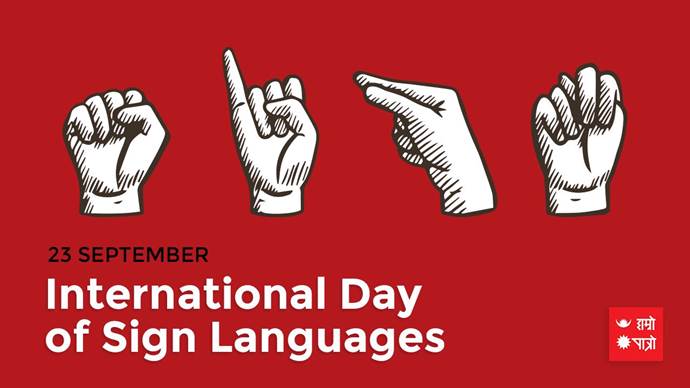Description

Copyright infringement not intended
About
- International Day of Sign Languages is observed on 23rd September.
- The Day was first celebrated in 2018 as part of the International Week of the Deaf by the United Nations General Assembly.
- The objective is to raise awareness of the importance of sign language in the full realization of the human rights of people who are deaf.
- The theme of this year's Sign Language Day-2022 is “Sign Languages Unite us”.
- On this occasion, the Indian Sign Language Research and Training Centre (ISLRTC) under the Union Ministry of Social Justice and Empowerment observed Sign Language Day at India International Centre (IIC), New Delhi.
- The objective was to sensitize the public about the importance of Indian sign languages.
- The Indian Government has ensured a dignified life for deaf people and other disabled people under the provisions of the Rights of Persons with Disabilities Act, 2016.

Rights of Persons with Disabilities Act, 2016
- The Act replaced the Persons with Disabilities Act of 1995.
- India is a signatory of the United National Convention on the Rights of Persons with Disabilities (UNCRPD). The act fulfils the commitment made by India at UNCRPD.
- Under the Act, types of disabilities have been increased from the existing 7 to 21 and it authorized the Central Government to add more types of disabilities.
- The 21 disabilities are;
- Blindness
- Low-vision
- Leprosy Cured persons
- Hearing Impairment (deaf and hard of hearing)
- Locomotors Disability
- Dwarfism
- Intellectual Disability
- Mental Illness
- Autism Spectrum Disorder
- Cerebral Palsy
- Muscular Dystrophy
- Chronic Neurological conditions
- Specific Learning Disabilities
- Multiple Sclerosis
- Speech and Language disability
- Thalassemia
- Haemophilia
- Sickle Cell Disease
- Multiple Disabilities including deaf, and blindness.
- Acid Attack victim
- Parkinson's disease
- First-time Speech and Language Disabilities and Specific Learning disabilities have been added to the list.
- Acid Attack Victims and Dwarfism are also included in the list of disabilities.
- The list of disabilities also included three blood disorders;
- Thalassemia
- Haemophilia
- Sickle Cell Disease
- Directed the governments to ensure that persons with disabilities enjoy their rights equally with others.
- Persons with benchmark disabilities and those with high support will get additional benefits such as reservations in higher education, government jobs, poverty alleviation schemes etc.
- Every child between the age group of 6 and 18 years with the benchmark disability shall have the right to free education.
- Ensure their accessibility in public buildings (both Government and private).
- Reservation in Public vacancies has been increased from 3% to 4% for persons with benchmark disability.
- Central and State Advisory Boards on Disability to serve as the highest policy-making bodies at the Central and State level.
- District-level committees by the State Governments to address local concerns of PwDs.
- National and State Fund to provide financial support to persons with disabilities.
- Strict Punishments and Penalties for offences committed against persons with disabilities.
- Special Courts in each district to take cases regarding violation of rights of PwDs.
- The Act provided an effective tool for ensuring their empowerment and true inclusion into mainstream society in an acceptable manner.
https://www.pib.gov.in/PressReleasePage.aspx?PRID=1861555
https://t.me/+hJqMV1O0se03Njk9














